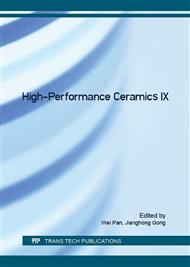p.101
p.105
p.109
p.113
p.119
p.124
p.129
p.134
p.138
Study on the Pore Structure of Forsterite Insulating Material
Abstract:
Forsterite insulating materials were prepared by molten salt method using forsterite powder, pulp waste, NaCl and Na2CO3 as raw material. The pore size distribution and pore structural parameters of the sample were studied by nitrogen adsorption-desorption method. The fractal dimension of pore was obtained based on FHH (Frenkel-Halsey-Hill) equation. The results showed that adsorption-desorption isotherm of the sample was identified as type II due to the long-narrow pore with narrow openings. The pore size and fractal dimension decreased with the temperature increased. The maximum pore size was about 2 nm in the sample heated at 1100°C in the condition of different content of molten salt. And optimal thermal insulation performance of the sample were obtained in the sample contained 30 wt% Na2CO3 and heat treated at 1100°C.
Info:
Periodical:
Pages:
119-123
Citation:
Online since:
July 2016
Authors:
Price:
Сopyright:
© 2016 Trans Tech Publications Ltd. All Rights Reserved
Share:
Citation:


